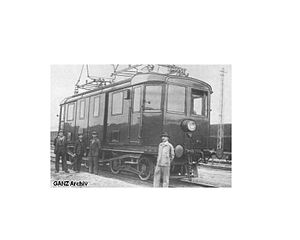MÁV series V51
| MÁV series V51 | |
|---|---|
|
Archive photo
|
|
| Numbering: | V51, 001-004 |
| Number: | 4th |
| Manufacturer: | mechan. Ringhoffer Prague-Smíchov el. SSW Budapest |
| Year of construction (s): | 1911 |
| Retirement: | 1948 |
| Axis formula : | B'B ' |
| Gauge : | 1435 mm ( standard gauge ) |
| Length over buffers: | 10,340 mm |
| Height: | 4,650 mm |
| Width: | 2,906 mm |
| Service mass: | 45.5 t |
| Friction mass: | 45.5 t |
| Wheel set mass : | 11.4 t |
| Top speed: | 40 km / h |
| Continuous output : | 354 kW |
| Wheel diameter: | 830 mm |
| Power system : | 11 kV 16 2/3 Hz AC |
| Number of traction motors: | 2 |
| Drive: | Slot drive rods |
| Brake: | Handbrake air brake type Westinghouse |
The MÁV series V51 was a series of electric luggage railcars of the Hungarian state railway Magyar Államvasutak (MÁV), which were used in island operation on the local railway Rákospalota - Vác electrified with 11 kV 16 2/3 Hz alternating voltage .
history
In 1911, a S-Bahn- like operation was introduced between Rákospalota and Vác near Budapest , with SSW from Budapest supplying both the electrical systems and the vehicles. A total of four luggage railcars were built as tractors for freight traffic and eleven passenger railcars.
The vehicle part of the luggage railcar was delivered by Ringhoffer in Prague- Smíchov. Initially they had the designation 1-4 , the MÁV then listed them as V51 soon after , when they took over the operation of the local railway. Although the vehicles were designed according to the Prussian EG 511 to EG 537 system , the engine required a lot of maintenance.
Application data cannot be found in the literature. The railcars were damaged during the Second World War . Since the catenary systems of the local railway suffered severe damage at the time, they were not rebuilt after the end of the war and steam locomotives continued to operate. As a result, the four luggage railcars were soon retired and scrapped.
Technical specifications
The railcars were each equipped with two single-phase series motors , which drove all four wheels by means of slot drive rods. The control took place via a switchgear by tapping different taps on the secondary side of the transformer .
See also
literature
- Mihály Kubinszky (ed.): Hungarian locomotives and railcars . Akadémiai Kiadó, Budapest 1975, ISBN 963-05-0125-2 .
Individual evidence
- ^ Mihály Kubinszky (ed.): Hungarian locomotives and railcars . Akadémiai Kiadó, Budapest 1975, ISBN 963-05-0125-2 . , Page 281
